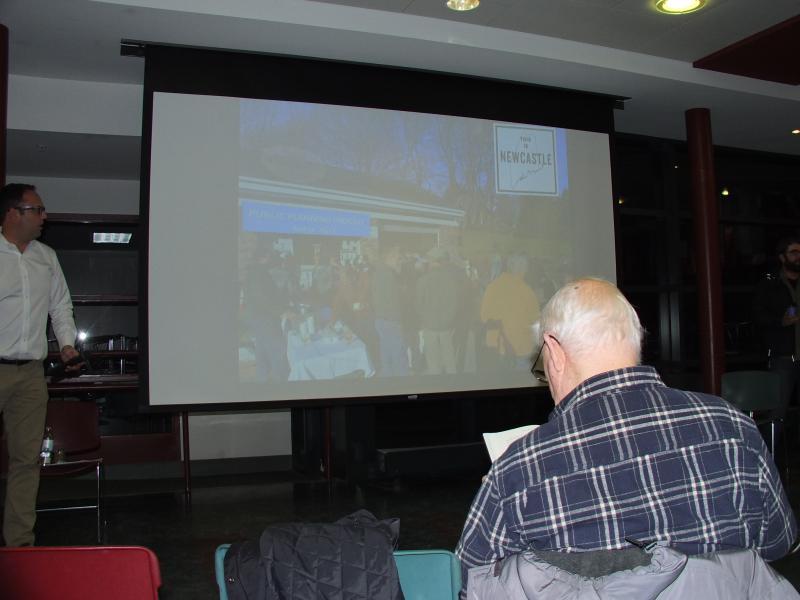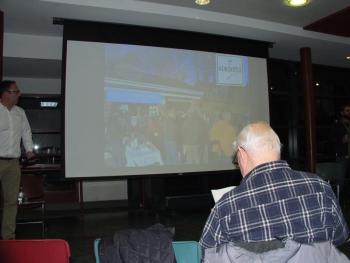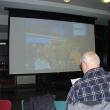Newcastle unveils comprehensive plan, ‘character codes’
 Russ Preston of the Principle Group begins the presentation for the Newcastle Comprehensive Plan. GINA HAMILTON/Wiscasset Newspaper
Russ Preston of the Principle Group begins the presentation for the Newcastle Comprehensive Plan. GINA HAMILTON/Wiscasset Newspaper
 Russ Preston of the Principle Group begins the presentation for the Newcastle Comprehensive Plan. GINA HAMILTON/Wiscasset Newspaper
Russ Preston of the Principle Group begins the presentation for the Newcastle Comprehensive Plan. GINA HAMILTON/Wiscasset Newspaper
Two years after they began, members of the Newcastle Local Planning Committee unveiled the first draft of a comprehensive plan and “character codes” during an event at Lincoln Academy’s dining commons on Dec. 6.
The whole community got involved at various points in the development of the plan, including a spring weekend event called a “charette,” where people made suggestions, many of which were incorporated into the draft document.
The comprehensive plan is based on a group of “character codes” that identify the character of particular neighborhoods as different categories of residential, rural, commercial, or mixed use.
Working with a company called Maine Design Workshop and people from the Principle Group, the Local Planning Committee and the town developed a straightforward system of connecting a new land use ordinance with a comprehensive plan. “Ordinarily, a comprehensive plan gets written and put on the shelf,” Ellen Dickens, co-chairman of the committee, said. “This system will incorporate land use ordinances with the comprehensive plan, so it will actually be used.”
The Principle Group’s Russ Preston said that zoning needs a vision, and he outlined five areas that would be incorporated into the plan.
The first area was “Claim Main Street.” Newcastle’s Main Street is in an odd position; Preston said it has better water access than Damariscotta, but it doesn’t have enough shop fronts and it doesn’t have a “character,” primarily because the bridge should have been located 10 feet south of where it is. Because of that, Newcastle’s buildings are set back 10 feet from the road and the space is used for parking. But Preston said the additional space opens up a number of possibilities, including parks, outdoor dining, and other attractive options. Another suggestion was to make the curved turn onto Main Street smaller, with the effect of slowing traffic, and having traffic make the left turn to get back onto Route One. This would provide space for an open town commons area, with a bandstand and seating, sidewalks, and possibly small businesses selling goods, or providing a good place for a local farmer’s market.
The second vision was “Be a Lifelong Community,” opening up a walkable town for children and the elderly, more biking opportunities and more places for kids to play and adults to relax. “This would help people who want to stay in the area but want to downsize,” he said. “The codes would allow additional houses on a lot that would let a relative live with some independence but to stay in the community,” Preston said.
The third vision was “Celebrate Local Heritage” and that would include housing styles from the town’s history, as well as establishing parks and statues that commemorate events in Newcastle’s history, and to make people aware of Newcastle’s place in history from prehistoric events onward.
The fourth was “Eco-Adventures,” taking advantage of Newcastle’s water and land opportunities, as well as its farming community, to attract visitors and make residents aware of things they can do. Preston said Newcastle has already done some of this, but the town could do more and with zoning laws that would allow, for instance, farm “vacations” or zip line or other amusements in special zones along Route One, more visitors would be likely to come and stay in Newcastle.
The fifth was “DIY Community” and “Bootstrapping.” He said many communities create exciting opportunities for residents and visitors with little more than the materials already at hand. Children could be encouraged to help create the kind of playground they want. Small businesses could arise to take advantage of live-work residences. Light industrial zones could appear in historically industrial areas, such as near the railroad, creating a dynamic, job-creating situation where none can currently exist because the area is zoned residential.
Several questions were asked afterward. People were interested in how this development would affect the local property tax rate. Selectman Ben Frey said it would increase the base and therefore lower the rate, eventually. Others wanted to know about alternative energy and how it would be encouraged, both in the residential districts and in the rural areas. Preston said alternative energies are well-supported throughout the plan, both in rural and residential and commercial areas. He explained the sizes of houses permissible in the various character zones, and Frey pointed out that most new construction would be able to be done administratively through the plan, saving the builder a great deal of time and money.
In general, the plan was well received. The whole first draft of the comprehensive plan and the character code will soon be available on the town’s website at http://newcastlemaine.us/.
Event Date
Address
United States





















